|

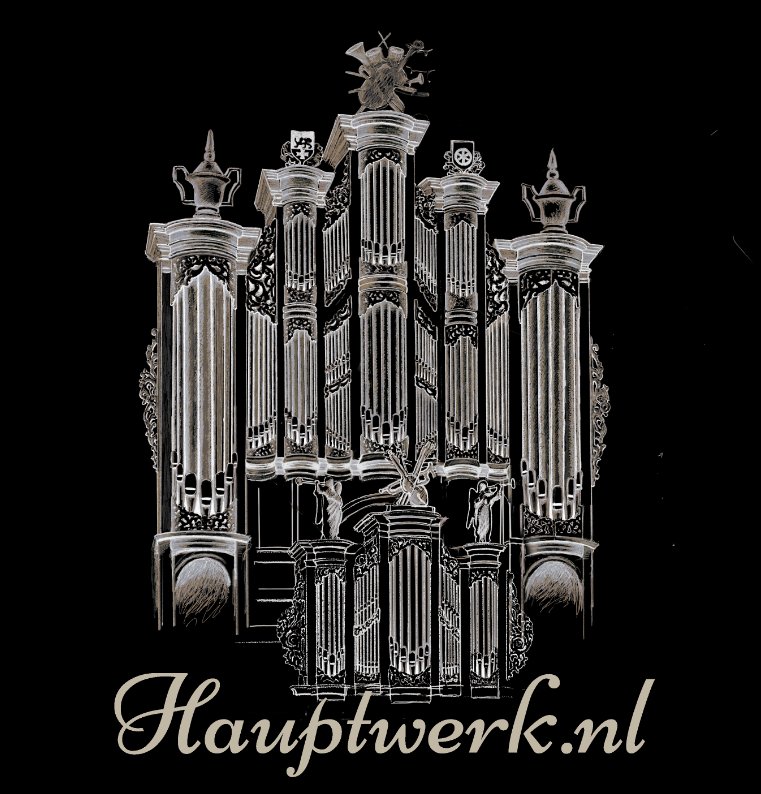








|
The Church.
The administrative district of Roeselare once belonged to the seigniory of Wijnendale, one of the most prominent seigniories in Flanders.
Roeselare slowly grew from village to town.
Around 1100 the whole area was converted to Christianity.
Chapels were established in Roeselare in 1093.
|
Protestantism.
Protestantism became established in overwhelmingly Catholic Flanders around 1870.
In 1874, Henri Tant, a textile industrialist, had his daughter Henriette baptized by a Protestant minister after some
disagreements with the clergy. In his factory he employed workers from the Protestant community, the so-called Geuzenhoek.
They formed a small, autonomous society. Early in July of 1878, the Protestant parish purchased a piece of land in what
is now the Jan Mahieustraat. On the 31st of July, 1878, Henriette Tant laid the first stone and the church was dedicated
on November 1st, 1879. Locally the church was known as 'De Geuzentempel.'
|
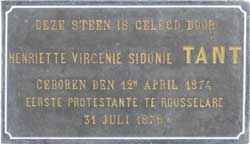
First stone laid
|
A jump forward in time.
In 1993 the signal was given to 'refresh' the church. The result was a major rebuilding whose purpose was to create more space.
The gallery in particular was thoroughly redone. Weekly meetings were held and during one of these meetings the chairperson suggested that,
'wouldn't it be nice to have a real organ in the gallery...a large piece of furniture with pipes and everything'
to replace the old and faithful harmonium. But it was just a dream; where was a small congregation going to get the money to
purchase something of this nature?
Indonesian Muslims build an organ in a Catholic city for a Protestant church.
Now that is ecumenical!
|

|
The road to the organ.
One can dream.
There was a rumour that a small business in Jakarta, Indonesia, namely the firm P.T. Prajawidya Instrumentalia
built harpsichords and organs. This small enterprise was founded in 1991 by Rev. Harry van Dop and Mr. Henk Vonk.
'Widya' means 'knowledge' as well as 'can make.' 'Praja' refers to a work place.
The founders made it their goal to serve current and future musical needs in Indonesia by constructing
instruments using indigenous materials. As such, it represents a continuation of an Indonesian cultural
tradition where crafts using materials from nature have a centuries long history of delivering quality musical instruments.
|
The congregation of the Geuzentemple made application for financial support to the board of the mayor and councillors
of Roeselare for a bamboo pipe organ. The response was positive.
They came from Djakarta to take pictures of the renewed gallery and to make precise measurements on site.
And .............. Almost immediately an order was placed for a bamboo pipe organ of 508 pipes,
10 stops and 3 manuals with Prajawidya. Meanwhile, in the hills of Bogor, a feverish search began for suitable bamboo canes.
Part of the progress report of January 1, 1995.
The organ intended for your church is approaching completion and should be installed in the course of this year.
Recently we have acquired a small building in which we can assemble the organ. Because of its height, we had to
establish a pit in the floor. We are planning to erect the organ in an atrium so that we can better judge the pipes during voicing.
Once the organ is completed, it is our intention to create publicity around this organ for a week in Djakarta.
It is important that Indonesian musicians are made aware of developments in their own country.
In June we will disassemble the organ, pack it up and prepare it for shipment in hermetically sealed, sterile containers. The organ should be in transit on the seas for one month'.
'Have a good trip, selámat jalan.'
|
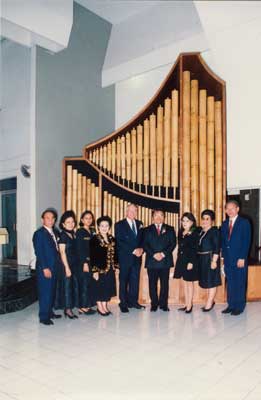
The organ erected in the University of Jakarta
|
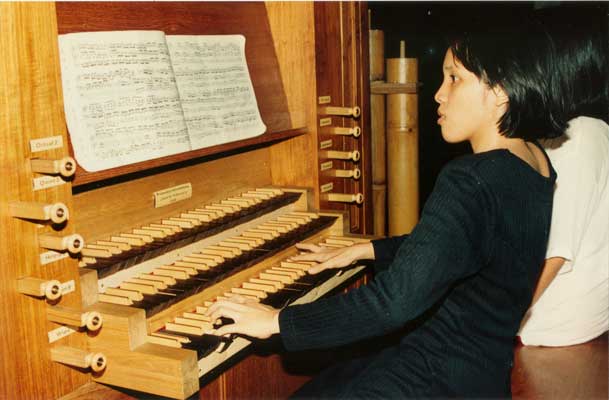
There was much interest in the organ
|
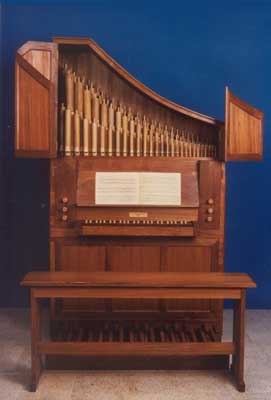
A positive of Prajawidya
|
In September, the organ builders SuwÓndi and Rajino from Prajawidya arrived in Belgium.
It took about a month before the organ was ready to be played. On the 14th of October, the organ was inaugurated and it
filled the church with its warm and completely harmonious sounds. A dream had become reality.
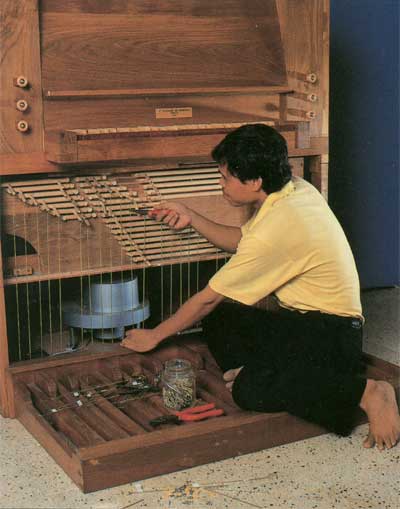
Mr. Suwandi is installing the pedals
|
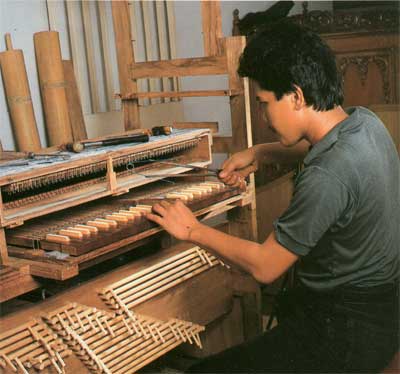
Mr. Sunardi placing the ventil springs
|
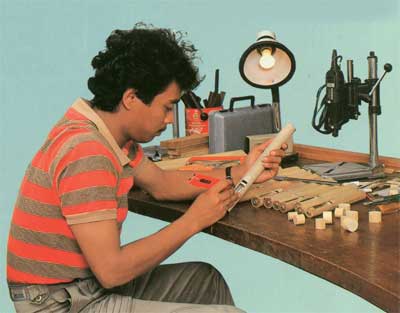
Mr. Rajino making the bamboo pipes in order
|
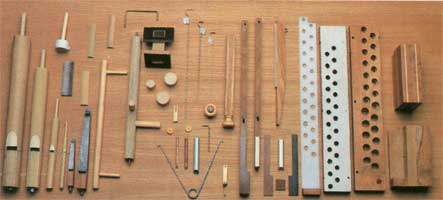
Miscellaneous small
materials
|
The instrument in Roeselare is the third in the world of a significant size after the one in Las Pinas (Philippines) and Porto Alegre (Brazil).
The Belgian climate creates special problems when it comes to temperature and humidity.
|

|
How a small section of tropical forest was turned step by step into a ready-to-play musical instrument.
A short report made by Henk Vonk during the construction of the instrument.
Bamboo is the material from which the pipes are made. The most suitable is found in the area around Bogor,
a little higher up on the hills. It has to be thin walled which makes it somewhat difficult to find. When the bamboo canes arrive,
they are still green and need to dry undisturbed for several months.
Initially, full sunlight has to be avoided since this creates stresses which quickly causes the bamboo to split.
With the large, wide bamboo, the diaphragms (the partitions between segments) need to be removed.
In Indonesia, bamboo is used not only for musical instruments but is suited to a thousand and one uses, e.g. in the construction industry.
Djati teakwood, which is particularly durable, is used for the case. We purchase the wood in log form and then cut it into planks.
The planks then spend 1.5 to 2 weeks in a drying oven until the water content is reduced to 8 or 9%.
For certain critical parts we use Sunkai, a light wood with long fibres.
For the key coverings on the keyboards we use ebony. It is a hard wood and a special saw blade is needed for cutting it.
In Indonesia this wood is known as 'Kayu Besi' or black wood. When it is polished it has a nice grain.
Once the organ is completed and the bellows provide sufficient wind at a pressure of 70 to 80 mm water column,
the important work of voicing begins. In an organ with bamboo pipes only, the variety of tone colours is of necessity
less than in an organ with pipes of wood and tin. The sound is very natural and the reason bamboo is often used in tropical
lands for making musical instruments.
Sources:
Roeselare heden en verleden. (Roeselare then and now).
Als dromen werkelijkheid worden, (When dreams become reality) Martine Dekeyser
For his hospitality and friendship we gratefully thank Rev. Alexander Eberson.
For the pictures and information we thank Mrs. Louise Vonk and Rev. Harry van Dop.
|
|
|
Hauptwerk.nl is an initiative from Sygsoft Holland. KvK 24400165. Last updated
2024-03-28
|
|
|